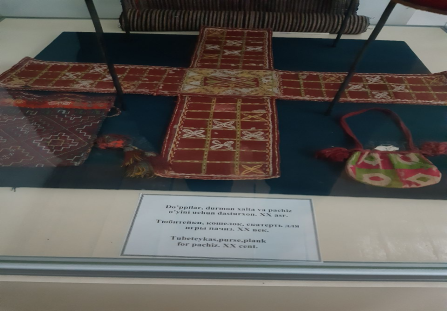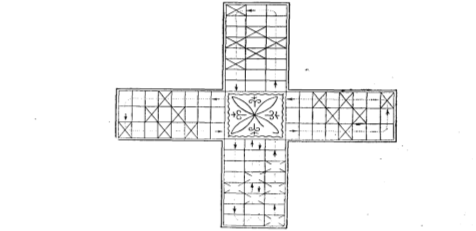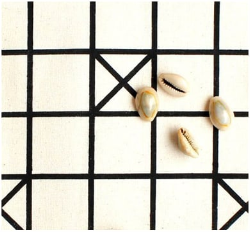The social significance of folk games (on the example of one of the folk games of the Khorezm oasis)
Автор: Махмудов Умрбек Бахтиёрович
Рубрика: 20. История
Опубликовано в
XXI международная научная конференция «Исследования молодых ученых» (Казань, июнь 2021)
Дата публикации: 31.05.2021
Статья просмотрена: 18 раз
Библиографическое описание:
Махмудов, У. Б. The social significance of folk games (on the example of one of the folk games of the Khorezm oasis) / У. Б. Махмудов. — Текст : непосредственный // Исследования молодых ученых : материалы XXI Междунар. науч. конф. (г. Казань, июнь 2021 г.). — Казань : Молодой ученый, 2021. — С. 37-40. — URL: https://moluch.ru/conf/stud/archive/396/16564/ (дата обращения: 25.04.2025).
The traditional games of the people of the Khorezm oasis are one of the material and spiritual treasures that have been passed down from ancestors to generations with their long history, unique fun and charm. Folk games at all stages of development have embodied the life, lifestyle, working conditions, nationality, religion and other characteristics of the people of their time and served to cultivate in the participants the qualities of agility, endurance, creativity, enthusiasm, strength.
This article is about the game “Pachiz”, which combines the ancient and ritual features of Khorezm.
Pachiz is one of the folk games, which was played until the 60s and 70s of the last century, but is now forgotten.
Pachiz is usually played by teenage boys at banquets. In Khorezm there were procedures for holding men’s receptions. A variety of games were played to make the men’s receptions fun, joyful and solemn. Pachiz had a special place in such parties as a game that shared the high spirits.
This game is similar to nardi[⃰] in terms of style of play and game elements.
In his research, ethnographer G.Snesarev observed that he married only in the Khorezm oasis, one of the regions of Central Asia without feathers. [4. C. 82].
The game of pachiz was played in the room where the banquet was held at a specific time (usually after the traditional meal was served). The game usually involved two or four players. Each of them was given four playing pieces (infantry) and all of these horses had the same value in the game. Agabi (dasturkhonchi) was chosen as the host of the game. He controlled the correct organization of the game, the observance of the participants in the game rules of the game [3].
The game was played on a special gambling table (which the locals called the “pachiz table”) (Fig. 1). The tablecloth is usually made from threads that are combined with plain black or blue velvet. They were usually sewn by women or male artisans (tanners, later seamstresses). The inside of the tablecloth is lined. At the end of the game, the four wings of the table were folded and the pedestrians were placed in a pocket in the center of the table. The tablecloth was spread out on the carpet, shells were carried along the carpet. In the game, all players threw shells, but only one, that is the main players of the sides, walked on foot [4].

Fig. 1. Pachiza table. The exhibit is kept in the Khorezm Musuem of Applied Arts. (Khiva Musuem-Reserve Ichankala)
The table consisted of 96 cells. Playing pieces move along these cages. Each playing pieces moved from the center of the game board (called a “talak”), rotated around the perimeter of the board and retirned to the center (Fig. 2.). Each walk is performed using an account obtained by throwing a seven-shell game bone (shell) onto the playing field. In the process, he was forced to start the game from the center point again by defeating the opponent’s foot. In the game, whoever puts his four playing pieces first in the center wins that victory [5, p. 83.].

Fig. 2. Playing pieces (pedestrian) movement at the pachiz table
The bones of the game — shells were chosen in the game, which were called «Snake» in Khorezm (Fig. 3). “Snake heads” have been found in the markets that are sold in smallions, or are the shape and weight they need to shells by players. Its back is cut down and the edges are flattened, and the hole is filled with lead or copper. The upper piece of metal is strengthened by wax. After that, the shells had the necessary shape and weight in shooting. The natural crack was called Picka, the wax called «Chikka». The mixture of seven shells was defined by the score (points) through the “Pikka” or “chikka”. There are 8 ways of such accounts: 2 pieces of piques and 5 are falling on 2 points — 3 points — 3 points, 4 «SE», 4 points If the pic and 3 pieces of smallness — 4 points, if the Chikka gets 7–6 points — 10 points — Das, 7 DACTs, 7 pieces of Das 12 points, it is 25 points, including «Pachiz», 6 piques, and 1 tort, with 30 points, such as 30 points, such as «Pachzod» [4].

Pic. 3. Pachiz game shells are snakes heads
The game was very intense, controversial. As the game was interesting, he did not know how fast he passed. The shells were shot down to high calls («Gal⃰ Pachiz», «either Pirim», «either Pirim, and other), were lucky. Especially at the end of the game, the passions ruptured and surrounded the surrounding the audience who was interested in who would win. The players also intensified excitement [3].
The attractive side of Pachiz Game is to defeat the opponent and defeat a variety of conditions for the defeat of the winner at the end of the game. This is a major part of the game. Because both players and the audience will wait for this. The terms of the Pachiz game were diverse. Ahead of the game, a condition will be an agreement on appointment. While in some games chooses the type of condition, some are set by the winners. Of course, the conditions were fabricated as a result of the fantasy of the game participants. We provide information about some of them:
— Eshak (donkey) — Like a missed donkey, the donkey is standing in four feet like a missing donkey and will ride the winner. The winner hits him, mocks by turning around the circle.
— Maymun (monkey) — is on the form of a defeat monkey, beating it, dancing.
— Kabutar (pigeon) — he is licking his defeat, and he pumping his hands on his wings. [5, C. 87].
Sending penalties show that these punishments require physical strength, strong patience and endurance. Therefore, only teenagers took part in the game, and their strength was tested through the terms of the game. Typically, the games were held between neighborhoods and villages, so special players of each region were special players. The selected players in the game competed for the honor of their territory. In this regard, gaming fans organized the majority and interested in the majority.
One of the Gurlanian information said, «His father's young Bashkore (servants). They were always responsible for regulating the breastrooms. The leisured time pachiz. Every year, when the banquet season expired, Pachiz was replaced by Ranks (Figease). The reason is that the players shell shell shoots, as well as excitement, were injured in injuries and failed to folds [2].
It can be said that courageous and prominent plan (tactics) in the game, as each participant fighted on the battlefield, and served to form the abilities to implement each work thoroughly, effective. Pachiz game also grows young men such as other national games in both spiritual and physically mature, and the real husband played an important role in the formation and development of young men.
References:
- Field notes. Gurlan district of Khorezm region. 2020.
- Field notes. Khorezm region Koshkopir district. 2020.
- Field notes. Khiva city of Khorezm region. 2020.
- Snesarev G. Pachiz. Sovetskaya ethnography. Tom 5, Moscow, 1962. — 178 C.
[⃰] It is a common game in the East, has a playground (board) and uses playing pieces and play bones (zarik, shout) to determine the score.
Похожие статьи
The structural composition of the folk tale Borma Yaryzhka as one of the elements of antiquity reception and its contribution to the development of political ideology of the Moscow kingdom in the middle of the 16th century
The article deals with the structural composition of a Russian folk tale about Borma Yaryzhka and presents an analysis of a number of its storylines borrowed from ancient literature or connected with it through ideological works of Russian publicists...
“New thinking” as a factor in the evolution of foreign policy on the example of the USSR, South Korea and Vietnam
This article examines the models of conducting foreign policy of the two countries of East and Southeast Asia (the Socialist Republic of Vietnam and the Republic of Korea) and the backgrounds of their formation in order to identify positive changes, ...
Byron and Uzbek literature (to the history of professional literary translations)
The article discusses the issues of professional literary translations of the works of the outstanding English romantic poet George Gordon Byron into the Uzbek language. The necessity of applying modern approaches to studying the heritage of the grea...
Borrowings in the Uzbek language: a historical review
The given article focuses on the problem of borrowing vocabulary in the Uzbek language with respecting to the historical perspective. The formation of the language composition, the main stages of which are described in this article, began in the Anci...
«The tale of the Grief-Mischief» as the work of the postprotreptic literature
The article considers the 17th century work «The tale of the Grief-Mischief» in the context of the time of creation — one of the turning points in the history of Russia. Two directions of protreptic are revealed, their features and historical conditi...
Peoples of the Caucasus in Central Kazakhstan: history and destiny
This work is dedicated to one of the saddest pages of Soviet history of the Stalin — the history of the forced deportation of the population of the Soviet Union aimed at the territory of Kazakhstan, in the Karaganda region, in particular. Having stud...
The Siege of Leningrad: An Analysis of D. Shostakovich and the Seventh Symphony
The article investigates the power of music and its ability to influence people, shape people’s identity and encourage nations to fight against all forms of oppression. The main focus is on the Seventh Symphony of D. Shostakovich, written and perform...
Похожие статьи
The structural composition of the folk tale Borma Yaryzhka as one of the elements of antiquity reception and its contribution to the development of political ideology of the Moscow kingdom in the middle of the 16th century
The article deals with the structural composition of a Russian folk tale about Borma Yaryzhka and presents an analysis of a number of its storylines borrowed from ancient literature or connected with it through ideological works of Russian publicists...
“New thinking” as a factor in the evolution of foreign policy on the example of the USSR, South Korea and Vietnam
This article examines the models of conducting foreign policy of the two countries of East and Southeast Asia (the Socialist Republic of Vietnam and the Republic of Korea) and the backgrounds of their formation in order to identify positive changes, ...
Byron and Uzbek literature (to the history of professional literary translations)
The article discusses the issues of professional literary translations of the works of the outstanding English romantic poet George Gordon Byron into the Uzbek language. The necessity of applying modern approaches to studying the heritage of the grea...
Borrowings in the Uzbek language: a historical review
The given article focuses on the problem of borrowing vocabulary in the Uzbek language with respecting to the historical perspective. The formation of the language composition, the main stages of which are described in this article, began in the Anci...
«The tale of the Grief-Mischief» as the work of the postprotreptic literature
The article considers the 17th century work «The tale of the Grief-Mischief» in the context of the time of creation — one of the turning points in the history of Russia. Two directions of protreptic are revealed, their features and historical conditi...
Peoples of the Caucasus in Central Kazakhstan: history and destiny
This work is dedicated to one of the saddest pages of Soviet history of the Stalin — the history of the forced deportation of the population of the Soviet Union aimed at the territory of Kazakhstan, in the Karaganda region, in particular. Having stud...
The Siege of Leningrad: An Analysis of D. Shostakovich and the Seventh Symphony
The article investigates the power of music and its ability to influence people, shape people’s identity and encourage nations to fight against all forms of oppression. The main focus is on the Seventh Symphony of D. Shostakovich, written and perform...











